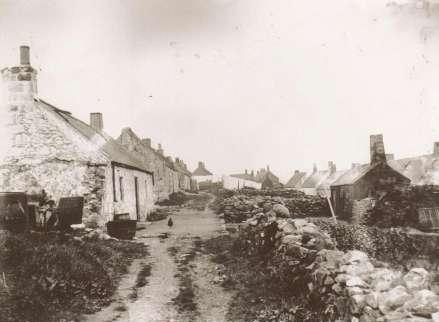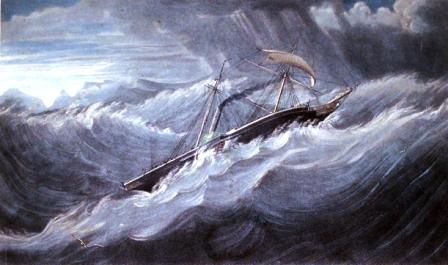
Wreck of the Dunstaffnage (1883) |
During February 1883 the ship Dunstaffnage was in Dundee offloading a cargo of 14000 bales of jute from Calcutta. After spending nearly a month in that port the ship was due to make her way to Liverpool and on the morning of Friday 16th March the 1800 tonne vessel set off in the tow of the Liverpool tug, Recovery. Their journey was to take them up the east coast of Scotland, through the Pentland Firth and then southwards along the west coast of Scotland towards their destination.
Captain Miller, skipper of the tug reported that at 2am on Saturday morning the wind was sweeping along the coast with relentless fury, and the showers of snow were so dense that nothing could be seen. The north easterly gale was whipping up the sea and at times his tug was almost completely under water, with the waves washing over the deck with great force.
It was at this time the towing hook of the tug suddenly snapped and the Dunstaffnage quickly drifted away and was soon lost from view, the last sighting being the crew trying to set sail in an attempt to reach the tug or maybe to keep clear of the land and aim for shelter, possibly the Firth of Forth some sixty miles distant to the south.
 Captain Miller searched the area for some hours but due
to the poor visibility no sign of the Dunstaffnage was found. As the
search was unsuccessful the captain decided to head for the Firth of
Forth but when he got there later that day where there was no news of
the missing ship. The tug then returned to Dundee to report the loss to
the ships agent and it was on his arrival there that he learned of the
fate of the unfortunate ship.
Captain Miller searched the area for some hours but due
to the poor visibility no sign of the Dunstaffnage was found. As the
search was unsuccessful the captain decided to head for the Firth of
Forth but when he got there later that day where there was no news of
the missing ship. The tug then returned to Dundee to report the loss to
the ships agent and it was on his arrival there that he learned of the
fate of the unfortunate ship.
So what happened to the Dunstaffnage after the tow line parted?
On the coast that night most of the Findon fishermen were engaged in saving their craft which had broken loose from their moorings within the small harbour – a combination of the stormy weather and the exceptionally high tides had alerted them to the dangerous situation in respect to the safety of their own small boats.
At first they were not aware of the drama that was playing itself out at sea close to their coast but at around 3am the first signs of a major incident became apparent to them. It was then that the first of the debris of a ship began to be washed ashore and the debris became more frequent as the night wore on. By daybreak it became obvious that a major shipwreck had occurred nearby as the wreckage was strewn over a three mile area of the coast. From some of the signs and articles that were cast ashore it became obvious that it was the Dunstaffnage that had hit the rocks and sunk.
No vessel had been seen in the area by any of the Findon fishermen or Coastguardsmen over the course of that night however observers in both Muchalls and Portlethen had been able to make out the vague shape of a large ship, being towed by a tug, struggling northwards through heavy seas, at a late hour on the Friday evening.
The exact point of where the ship stuck landfall is not known but bearing in mind that there was a strong northerly sea running the most likely point of impact would have been the headland of Findon Ness otherwise the ship would have probably continued drifting south for another mile before striking the unseen rocks of Craigmarroin. The fact that wreckage was being washed up in the locale of Findon shore would also indicate that the ship went down close to that area.
 Unfortunately there was no survivors left to tell the
tale of the exact fate of the Dunstaffnage and a total of 24 souls lost
their lives on this cold March night. This is likely to have been the
largest loss of life in our area due to a single shipwreck.
Unfortunately there was no survivors left to tell the
tale of the exact fate of the Dunstaffnage and a total of 24 souls lost
their lives on this cold March night. This is likely to have been the
largest loss of life in our area due to a single shipwreck.
The subsequent enquiry held in Liverpool focussed on the Tug’s role in the drama – should the journey have been attempted in such weather conditions given that a similar and recent incident with another ship being towed around the north of Scotland had resulted in a shipwreck on the west coast? Questions were also raised as to how long the Tug spent searching for the Dunstaffnage after the towing line had parted and whether Captain Miller should have remained in the area longer in an attempt to locate the vessel. Unfortunately I’ve been unable to unearth the results or recommendations from the enquiry so will have to assume that the cause of this shipwreck, like many before it, was down to the severe weather and a stroke of bad luck.
During the same storm a number of small boats were also lost from the local villages, these included two being wrecked at Downies, one from Portlethen and another at Findon. These losses would have been felt more heavily by the local communities than the loss of the Dunstaffnage because the fishing villages were dependant on their craft for their livelihood.